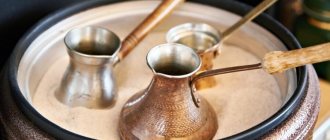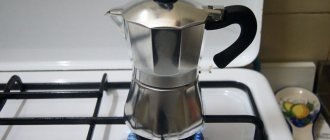Even before progress gave coffee lovers professional coffee makers and coffee machines, most people used Turks to brew an invigorating morning drink. Most often, coffee lovers use metal utensils to brew coffee. Not many people know that there is a clay coffee pot and how to use such a device is also a big mystery to most. In this article we will examine this issue in detail, paying special attention to the use of clay utensils for brewing coffee on different cooking surfaces.
Pros and cons of clay Turks
Turks made from clay have a number of advantages. Among them are:
- porosity of the structure, thanks to this the coffee is saturated with oxygen and greatly reveals its taste properties;
- environmental friendliness of the material. It is not dangerous to human health;
- low thermal conductivity, due to which the vessel heats up moderately and cools down slowly, which improves the quality of the finished drink.
In addition to their advantages, such Turks also have disadvantages. Among them are the fragility of containers and sensitivity to temperature changes.
During cooking, the clay retains a coffee smell, which is why only one coffee variety should be brewed in one vessel.
How to use
To brew a high-quality drink, you should know how to use a clay cezve correctly. To do this you will need the following tips:
- before the first use, the vessel must be thoroughly rinsed without using detergents - it is best to soak the container for 1 hour in clean water;
- to get rid of the aroma of the previous type of coffee beans, it is recommended to fill the Turk with water and heat it on the stove a couple of times;
- During manufacturing, temperature changes must be excluded.
There are also tips on using clay cezves on different slabs.
On a gas stove
A clay pot for brewing coffee on a gas stove can only be used with a divider. This is justified by the fact that temperature changes are unsafe for clay. They provoke the appearance of cracks on the surface of the vessel. If you use a divider, the casing will warm up moderately, and its integrity will not be compromised.
On electronic
Coffee in a clay pot can be prepared on an electric stove. In this case, the radius of the burner should be covered by the bottom of the vessel by 70-80%. Heating must be inactive, otherwise the container may crack. To prevent coffee from running away, it is recommended to remove it from the heating element when the water temperature reaches 90 degrees.
On induction
A special feature of clay Turks is the impossibility of using them on an induction cooker without additional devices. To brew coffee, you will need to purchase an induction adapter, which will help activate the heating and warm the vessel moderately. The best option is the introduction of ferromagnetic adapters.
If you don’t want to take such a device, you can make coffee in a clay pot using other items. In this case, you need to place a frying pan on the burner and fill it with sand. The Turk is immersed in the sand, and the coffee is prepared while it is evenly heated.
On glass-ceramic
A special feature of glass-ceramic plates is the fragility of their coating. Therefore, it is impossible to use metal Turks to make coffee on it. A good option would be to use a cezve made of clay or porcelain.
It is worth considering that clay products must have a thick, wide bottom to prevent the possibility of overheating of the burner and the vessel itself.
Rules for using ceramic Turks
Utensils have their own rules and limitations that must be taken into account before you start making coffee.
Ceramic cezves are suitable for making coffee on a gas or electric stove. They prepare coffee on sand and even in the microwave.
Ceramic cannot be used on induction cookers. We wrote about Turks for induction cookers in this article.
Glazed ceramics do not like sudden temperature changes. Before washing the Turk after use, let it cool thoroughly.
Never place a very cold cezve on a hot burner.
- Clean dishes using warm water and non-abrasive detergents.
- Ceramic Turk is not afraid of fire and heat, since special fire-resistant ceramics are used for the dishes, however, it remains fragile and does not withstand impact loads well.
- You can warm up an empty cezve over a fire, just like you can caramelize sugar in it, provided that the inner coating of the cezve is not made of glass ceramics.
How to brew coffee in a clay pot
To prepare coffee in a clay pot that really reveals its flavor and fragrant properties, you can use the instructions below.
- The required amount of coffee powder is poured into a washed and dried container. It must be prepared before brewing a drink from perfectly roasted grains. Medium-roasted raw materials are considered a good option.
- Then water is poured into the vessel. Its quantity should not exceed the level of the narrowest point of the cezve.
- The container is placed on the burner and warmed up. At this time, it is necessary to actively monitor the product so that it does not boil away.
- When foam appears on the surface of the drink, it is recommended to remove the Turk from the heat and let the drink sit for a couple of minutes.
If you need to get strong coffee, it is recommended to repeat the heating function 2-3 times. In this case, the coffee beans will give the water their own taste and smell. If you need to brew a “soft” drink, it is not recommended to reheat the liquid. In this case, it is enough to leave it in a hot pot for 3-5 minutes. Thanks to the appropriate thermal conductivity of the clay, the container will maintain temperature for a long time, which will allow the grains to reveal their own taste and smell.
If you want to brew Turkish coffee, you can use sand. You can prepare such a drink on any stove. To do this, place a frying pan on the burner, and the diameter of its bottom must correspond to the size of the heating element of the stove. Then you just need to follow the annotation:
- Sand and a small amount of pebbles are poured into the frying pan.
- The bottom of the cezve is immersed in the sand in the center of the frying pan.
- The required amount of coffee powder is placed in the vessel and water is poured.
- Then the heating turns on.
- When foam appears on the surface of the water, it is recommended to remove the Turk from the sand.
- The heating function must be repeated 2-3 times.
- Sugar is added to the drink as needed. This must be done after the coffee has been poured into the cup.
You can make different drinks from coffee prepared in a clay pot - Americano, latte, macchiato, cappuccino. In this case, you will need to take the main ingredients in different proportions, complement their taste with secondary components, for example, milk, chocolate, syrup. Some recipes suggest diluting water with regular water.
Features of clay Turks, how they differ, how to brew coffee in a clay cezve.
It is difficult to imagine the modern lifestyle of many people without waking up in the morning to the smell of coffee. An ancient and more correct method of making this invigorating drink is considered to be brewing in a Turk. Clay Turk is considered popular, natural and affordable. There are also other types of cezves made of ceramics and copper.
Pros and cons of clay Turks
To get high-quality, fragrant coffee, it is recommended to pay attention to all types of cezves that are on the market. The quality of the material affects the speed of coffee production, its richness, smell and taste. Many fans of the coffee drink believe that a clay Turk is better than clay or copper. Especially if it is made from Yixing clay. This Chinese clay (from the town of Yixing), thanks to its own structure, saturates coffee with oxygen, which gives it a divine smell and taste. Unfortunately, not everyone can afford to find and purchase Turka from this oriental material, but even ordinary clay has its advantages and has a beneficial effect on the quality of coffee.
Advantages
In ancient times, clay Turks were used by poor commoners who could not afford copper utensils (it was available only to aristocrats). Modern coffee lovers find a number of advantages of cezves made from clay, which explains their popularity.
The advantages of using a clay cezve include:
- The porous structure of the clay enriches the coffee with oxygen and increases its aroma;
- The material is environmentally friendly, which makes it non-hazardous to the body;
- Low thermal conductivity, which helps maintain the temperature of the drink. After the coffee is infused in such a container, it will acquire an indescribable deep taste;
- Uniform heating helps to evenly reveal all the properties of the coffee drink and taste properties;
- Availability and wide range allow coffee lovers to purchase utensils for making coffee of various types and sizes. Even a handmade Turk will not be scared off by the numbers on the price tag. If Yixing clay is used, the cost of dishes will be even higher than those made from ordinary clay.
Disadvantages
The peculiarities of a clay Turk may discourage coffee lovers from using this type of cezve. Disadvantages:
- Preserves the smell of coffee. Due to the porous structure of the wall, Turks are saturated with the qualities of the first coffee brewed in it. New coffee beans will not reach their full flavor potential due to the taste of the previous brewing. Therefore, it is better to brew one type of coffee in a Turkish coffee pot.
- Constant control over the manufacturing process. Due to the fact that the clay cools slowly, the coffee continues to rise even when the Turk is removed from the heat. You need to learn to control the process of brewing an invigorating drink.
- Sensitivity to temperature changes. Do not suddenly cool pottery after heating because it may crack. When making a coffee drink, it is better to place a cool pot over low heat so that it heats up moderately and there is no sudden temperature change.
- Fragility. It is quite easy to break this type of cookware, especially if the floor is tiled.
Which Turk is better, clay or clay?
Along with clay Turks, clay making is also popular. They are also made from baked clay, but have a final glaze coating. The surface can be glossy or matte.
The main feature that distinguishes earthenware from earthenware is that ceramics do not absorb odors. This material does not interact with the external environment, does not oxidize, and therefore will simply get rid of traces of a previously prepared drink. Ceramics are easy to wash and are quite easy to rinse with water.
Therefore, if a person does not drink one type of coffee, but often brews different types of coffee beans, then he should give preference to a ceramic pot. It retains all the positive characteristics of clay, in addition it removes traces of past cooking.
Which Turk is better, clay or copper?
In ancient times, a copper cezve was considered a sign of wealth; only high-ranking officials used it. At the moment, only true coffee connoisseurs prefer this type of Turkish coffee. Copper has its own differences from clay, as well as some peculiarities. To decide which type of material is more suitable for a coffee lover, you need to familiarize yourself with its qualities.
Copper differs from clay in that it heats up and cools down quite quickly. This does not allow the coffee to simmer, thereby saturating it with taste and smell, as in clay Turks. However, you can reveal all the flavor properties in copper dishes even with the help of hot sand, thanks to its good thermal conductivity.
Fundamentally! Just like clay, copper has the ability to absorb coffee odors, so lovers of an invigorating drink should also pay attention to this.
The essential minimum for excellent taste
You can prepare an amazingly tasty drink on a regular stove. It is enough to stock up on high-quality Turkish tea, clean drinking water and understand the basic principles of brewing. There are countless recipes for making coffee at home. They indicate how much and what varieties to use, what spices and additional ingredients to add. However, you can begin creative experiments only after learning the basics, otherwise you can ruin the taste of even the most exquisite varieties.
We select a Turkish woman
Turk is a classic utensil that allows you to brew coffee correctly. For thousands of years, the aromatic drink was brewed in copper, achieving the maximum development of taste.
Ceramic and clay
Gourmets who enjoy the process of preparing the elixir of vigor prefer to use a clay pot. The porous structure of the clay is thoroughly saturated with the taste and aroma of coffee grounds, so for each type it is necessary to have a separate container for brewing.
Ceramic products are more versatile, but have a capricious disposition - they are “afraid” of mechanical damage and require careful adherence to temperature conditions.
It is difficult to use ceramics and clay - one awkward move and your beloved Turk breaks down. Don't feel the need to go fancy and just want to make decent coffee every day? Then use a traditional copper cezve.
Copper
Copper Turks are ideal for preparing coffee masterpieces at home. The metal heats up evenly, allowing you to prepare the drink quite carefully. Using a cezve is easy - brewing does not take much time.
When brewing coffee in a pot with a narrow neck, it is important not to miss the moment of boiling, otherwise the coffee will “run away”
Which Turk should you choose to brew a very tasty drink? There are two types of products - with a wide and narrow neck. The ideal development of the taste qualities of grain coffee allows you to achieve a cezve with a thin throat. However, it is quite difficult to cook in it, since the drink tends to instantly “run away” before boiling. It is much easier to brew coffee in a Turkish coffee pot with a wide top, but the taste will be less rich.
Before purchasing any type of cezve, you should make sure that the inner surface is high-quality coated with food-grade tin, which protects people from the harmful metal impurities characteristic of copper.
A small-sized Turk is considered ideal, allowing you to cook only one portion (from 75 to 100 ml). Are there many coffee drinkers in your family? It is more profitable to use large cezves. The final drink is less strong, but everyone can enjoy it at the same time.
Clean water – delicious coffee
You need to brew the drink wisely! Chlorinated or boiled water will not reveal the true taste of selected grains. Use purified or spring (bottled) water. Are you used to taking water from the tap? Then accept that even the most expensive varieties will not be able to make the right impression on you - bad water simply kills their taste.
Brief tips for brewing:
- “Boiling means killing,” coffee is brewed over low heat and removed from the stove a moment before the boil begins. A boiled drink loses 70% of its taste and aroma.
- “Don’t forget to warm it up,” - before preparing the elixir of vigor, the Turk needs to warm it up well.
- “Beans for once” - it is not customary to prepare grain coffee “for reserve”. The grains are ground on a one-time basis. How much do you need to grind? Depends on the desired volumes and expected strength.
- “Sugar is friends with coffee,” - those with a sweet tooth should remember that sugar is added along with ground beans. And then everything is poured with water and cooked over low heat.
- “Slow and tasty” - want to get a tasty drink? Use the lowest heat possible.
How to choose the right clay Turk
Today the market provides a large selection of cezves of various types and sizes. Clay Turks are widely represented by both artisans and factory creations. Anyone who prefers factory-made cookware can be confident in the strength of the material and its quality. After all, they are all tested for fire resistance and have a guarantee of use.
Handmade Turks also find their own buyers. Many people prefer the ancient method of producing cezves because the soul and positive energy of the artisan is put into them. Therefore, the drink will have a more generous taste and smell. Handmade Turks are also distinguished by personal decorative processing on the outside. You can choose them as a gift or for your collection.
In order to choose the right cezve, you need to pay attention to the following:
- The shape of the dish should be in the form of a cone (with a narrow neck and a wide bottom);
- The walls of the Turk should be quite thick (otherwise it can quickly crack due to temperature changes);
- There should be no damage, cracks, or roughness inside;
- The handle should be at an angle, rather long and not get hot.
Turk with which handle is better
The main process takes place in the body of the cezve, but a comfortable and strong handle is an important factor in ease of use. Which handle for a Turk will be the most suitable?
Material of manufacture
- Metal. Such handles are usually found in cheap aluminum bowls. Metal holders heat up quickly, so be sure to use oven mitts for them.
- Tree. Handles for copper and sometimes ceramic Turks are made from it. The wood does not heat up and allows you to take dishes with an unprotected hand.
- Plastic. Nowadays the so-called bakelite is popular. It does not heat up, does not melt, and is lightweight. It is from this that holders for glass and steel Turks are made. Sometimes it is used for copper cookware.
Fastening
- Bolted on. In this case, the holder is attached to the body using two bolts, their heads are visible on the inside of the Turk. The fastening is reliable, lasts a long time and has proven itself well.
- On the solder. Soldered handles are less reliable. Modern Turks are coated with various compounds to prevent them from oxidizing. These compounds sometimes interfere with the quality of adhesion during soldering. Therefore, handles soldered to the Turk may fail at the most inopportune moment.
It is best to have a Turk with a wooden or bakelite handle secured with bolts.
How to brew coffee in a clay pot
To make a tasty and fragrant invigorating drink in a clay pot you need:
- Pour the required amount of ground coffee beans into a dry, clean cezve (the amount of coffee depends on the desired strength of the drink);
- Add water up to the narrowest part of the neck;
- Put on fire;
- Wait until the boiling point (but do not boil!) and let sit for a few minutes.
It should be noted that you should not bring the coffee to a boil three times (as when using copper cezves). It is enough to throw the just brewed invigorating drink for 3-5 minutes in the Turk to reveal all its taste characteristics.
Is it possible to brew coffee in a clay pot on a gas stove?
Due to the fact that clay is quite vulnerable to temperature changes, many people ask whether it is possible to put a clay Turk on gas. If you place a special fire spreader on the stove, it will be moderately distributed over the entire surface of the bottom, and there will be no risk of damage to the cookware.
We choose a product depending on the country of origin
The same grapevine variety produces berries that are very different in their taste characteristics. Likewise, the yield of an Arabica tree depends largely on terroir. Climate, soils and altitude above sea level affect the grains. It's hard to say which coffee is best for Turkish coffee. In reviews, gourmets praise different varieties, and depending on your taste preferences, you can choose the manufacturer that suits you. So, let's look at the map of countries where coffee is grown.
- Ethiopia. The homeland of Arabica, produces excellent quality beans. The drink brewed from them is strong and has a chocolate taste with light wine and spicy notes.
- Yemen and Kenya. Medium acidity, high caffeine content. The aromas of green apple and citrus are clearly felt in the bouquet.
- India. Beans from this country will appeal to those who do not like sourness. The drink has a bittersweet taste of dark chocolate.
- Tanzania. AA is considered the best variety from this country. The drink has a velvety soft taste with notes of almond.
- Brazil. Soils contain quinine, which is why coffee often has an unpleasant medicinal smell. Grains from Brazil are used in blends to give the melange strength and expressiveness.
- Qubit. Single-varietal coffee from Liberty Island is rarely found on sale because it has high acidity. It is used for blends. But those who have tried pure coffee from Cuba claim that the drink has a delicious vanilla taste with the aroma of cigars.
- Indonesia. The taste of coffee contains the sweetness and spiciness of spices. The bouquet is woven from an amazing mixture of honey, cardamom and spices.
- Burundi. For those who love sourness, this is the best bean coffee for Turkish coffee. The aroma reveals berries, fruits and flowers.
- Salvador. Natural sweetness allows you to not even add sugar to the drink!
- Brazil. The country is large enough to produce drinks with different flavors. Santos with distinct chocolate notes is popular.
Features of operation and care
If you have an idea of the physical properties of clay, then you can figure out how to properly use such utensils.
Before using it for the first time, you need to thoroughly wash the purchased clay pot; it is better to boil water in it. You can also put it in a container of water and leave it there for an hour. Then rinse and wipe dry.
You cannot use detergents to wash a clay cezve, because their residues end up in the drink and can spoil the entire memory of coffee pleasure.
If you had to change the type of coffee, then before brewing it is better to wash the Turk in hot water a couple of times. This will help get rid of the trace and aroma of the previous type of drink. Modern clay cezves have a special protective coating on the inside. It is enough to rinse such dishes with water.
On a note! Many true connoisseurs say that you can completely get rid of the taste and smell of the previous coffee variety in a clay pot only by brewing a new coffee variety a couple of times.
It is best to start the process of preparing coffee in a clay pot on gas with a small fire that does not go beyond the bottom. With all this, it will be great when the stove is cool at first. After turning off the heat, the boiling will stop, but the coffee will continue to enrich in taste and aroma.
You should be careful and not expose the cezve to mechanical stress. Even a small blow can turn into a trip to the store for the latest cookware.
Best materials
Most of all, modern Turks differ precisely in the material of manufacture. Aluminum cookware is produced using industrial stamping, while different grades of food grade metal alloys are processed. The coffee brewing tool turns out to be very light and convenient, but at the same time reliable - it cannot be broken by accidentally letting go of it. The aluminum Turk is easy to use and costs only 200 rubles.
However, this material has a number of disadvantages. Although the Turk will not break if dropped, it may be visually damaged, for example, scratched or bent, since the material is soft. Low weight causes the cookware to lose stability. Since the models are made with almost identical neck and bottom diameters, the aroma of the finished drink does not linger for long. Finally, aluminum Turks are not particularly aesthetically pleasing.
Brass is most often used to make a copper Turk, although other copper alloys can also be used. The dishes are created both by stamping and by hand. The inside of copper Turks must be treated with food grade tin to avoid dangerous oxidation. The cone-shaped shape of such dishes is considered ideal, and the ratio of the bottom and neck preserves the taste and smell of the drink in the best possible way. The copper pot is durable, safe, heats the water evenly and does not cost fabulous sums - the price ranges from 700 to 1000 rubles. It looks very aesthetically pleasing.
As for the shortcomings, the copper Turk has them, but they do not look so critical. Firstly, from time to time it will have to be cleaned additionally, since regular washing is not enough. Secondly, the walls of the dishes absorb odors, especially if they are used for a long time, which again may not be to your liking.
What is called a ceramic Turk is created from clay and plasticizers. Visually, clay models differ significantly, as they can be hand-made or industrially produced, covered with glaze or without any additional protective coating. The advantages of such dishes include, first of all, their environmental friendliness and safety for human health.
Thanks to the thick walls, cone-shaped shape and optimal ratio of the diameters of the neck and bottom, the drink is evenly boiled and turns out amazing. In addition, you can always choose an unusual design that is ideal for a specific kitchen.
A cezve made of glass requires a special borosilicate material that remains stable when heated. Its production is possible only in industrial conditions. The glass cezve looks very stylish and greatly simplifies the operation process, since thanks to the transparent walls it is possible to control the process. A standard container, the volume of which is 500 milliliters, costs from 350 to 500 rubles. It is easy to care for and comfortable to use.
It is worth adding that such a Turk can also be used for heating liquids or even cooking soup.
Silver cezves, created in industrial conditions or in special workshops, are often presented as gifts for major dates. Such dishes have the necessary cone shape, are durable and look very beautiful. However, silverware requires rather difficult conditions of use and care. The water in it boils too quickly, which has a bad effect on the taste of the drink.
To make a stainless steel cezve, an alloy of steel, chromium or zinc is used. The last two metals are responsible for preventing oxidation processes. Such dishes are created only at the factory. The positive qualities of stainless steel Turks include durability, ease of use and low cost.
Reviews about clay Turks
Alexandra, 32 years old:
I tried a clay cezve for the first time while in the field. It was possible to keep the coffee warm longer; the taste is no different from the drink prepared in a homemade copper pot.
I always use a Turk made of clay or ceramics. The drink always comes out perfect, the main thing is to know how to prepare it correctly.
Dmitry, 23 years old:
I was unable to specifically study the merits of this type of Turk. It broke 2 days after purchase, accidentally dropped it on the floor. Fragility is, of course, a big minus. Most likely I will buy a copper Turk now.
A clay cezve will help you get high-quality coffee, despite its cheapness and availability. Such a Turk retains heat longer, the better revealing the smell and taste of a certain type of coffee. You should know the features of this type of cookware and be able to use it correctly.
Turk made of clay: advantages, disadvantages and features.
Clay Turks are one of the most common and favorite types of cezves. which have a fairly low cost.
It is believed that Isshin clay is a good material for their production; its particular structure allows the drink to be saturated with oxygen during brewing, which makes it even more fragrant.
Yixing clay is clay that is mined in the area of the town of Yixing in China. It is distinguished by the highest content of kaolin and small silicate particles, this allows, after firing, to obtain a porous structure and a greasy surface shine.
There are two types of pores: open and closed, this ensures that the coffee is saturated with oxygen and makes it more fragrant, and the water in Isshin clay containers cools more slowly.
Most likely, in our sale you will almost find Turks made from clay mined in the town of Isin, and ordinary clay Turks are quite a good choice among other types of coffee Turks.
Advantages of clay Turks:
- Low cost - compared to metal Turks, they are significantly cheaper;
- Large selection - in almost all towns, clay Turks are presented in a wide range;
- Saturation of the drink with oxygen - as mentioned above, due to the porosity of the clay, coffee is saturated with oxygen during brewing, which makes it more fragrant.
The clay coffee pot has the following disadvantages and features:
- Inertia - due to the large thickness of the walls, as soon as the coffee begins to rise, you need to remove the Turk from the heat, since due to the accumulated heat of the walls, the coffee will continue to rise. It takes a little practice to get the hang of brewing coffee in a clay pot;
- Preserves the smell of coffee - the walls, due to their own porosity, absorb the smell; coffee in a clay pot is better to prepare only the first grade;
- Features of cooking - it is better to place a similar Turk for comfort with a divider; an even better option is to make it on sand (a thick layer of sand is poured onto the frying pan and a clay Turk is placed in the recess in it);
- Caring for a clay pot - you can’t wash it right away after you spill coffee; the material is sensitive to temperature changes and will most likely crack. Also, don't put a hot cezve in the sink, just put it back on the stove, where it will cool evenly.
Me, me again and the Ceraflame Ibricks clay pot.
Our first meeting happened by chance. I met her on the Internet and immediately fell in love with her. A 100% clay pot from the Brazilian brand Ceraflame, chocolate color – sophisticated design, removable handle, in general, everything I wanted.
With the appearance of a new Turk in the house, the old iron one had to be put into the closet. Going to bed in the evening, I was looking forward to the morning so that I could quickly brew coffee in the new Turk; brewing coffee in the evening seemed to me a rather incomprehensible idea. For the newest Turk, I even bought new coffee, with chocolate flavor, so that I would have a complete chocolate set. I usually drink stronger coffee in the morning. So I put in almost a whole tablespoon and poured boiling water over it. During the day, I prefer to take a nap longer, because I don’t have enough time to get ready, and it’s more convenient for me to boil the kettle first, and then pour hot water into the coffee; the taste doesn’t suffer from this, and it takes less time.
With the last Turk, everything went according to a correctly worked out scenario - you pour boiling water, put it on the gas and after half a minute the coffee is already rising, the main thing is not to miss the moment of boiling. With the clay Turk, actions developed according to a completely different scenario. As they say - the first damn thing is lumpy. Having put the Turk on the stove, I waited for sure, about 1.5 minutes - and nothing happened, this alarmed me. But later, when I saw that the coffee began to rise, I quickly turned off the gas - but this did not help the coffee - it continued to rise and eventually ran away.
I, a newcomer, was not previously aware of the characteristics of pottery, since I simply did not have any. I decided to clarify this issue, and here’s what I found out: ceramic dishes take a long time to heat up, and later also provide this heat for a long time. Now let’s project the acquired data onto our situation - the Turk with coffee heated up for a long time, absorbed the heat, and later, when the coffee began to rise, I turned off the gas. But it was too late - the Turk continued to give off heat, even without heating, so the coffee continued its rise and finally reached the edges and moved to my stove. Such losses can be incurred when you remove coffee from the heat at the wrong time and do not know the features of ceramic dishes.
The next time, the coffee brewed in this pot came out divinely tasty and fragrant. Finding freshly made homemade ice cream in the refrigerator and adding it to my coffee, I got a wonderful ice cream.
Thick clay walls are a big plus for clay Turks. They retain a lot of heat, so the extraction process continues for some time even after removing the turk from the heat. And thanks to them, your drink will heat up moderately, providing a good taste.
Therefore, we brew coffee in a Turk correctly:
- Let's take the Turk
- Add softer/stronger coffee
- Pour boiling water
- Let's put it on gas
- And the most important thing: wait until the first bubbles appear
- Turn off the gas - the coffee will rise on its own, since the Turk will continue to give off heat. True coffee connoisseurs choose these Turks, they produce unsurpassed coffee, and one more thing - they look great in the interior!
The full collection of CERAFLAME Turks can be seen here:
Clay Turk.
Of all the recognizable types of utensils for making coffee, the clay Turk is perhaps one of the most ancient options. Some are inclined to give the palm to the copper cezve, but it appeared in the Shah's palaces and in rich trading houses. Copper, like other metals, was in short supply; clay was more accessible. That’s why ordinary Arab nomads and poor pilgrims used pottery specifically. Probably the discoverers of coffee, the inhabitants of glorious Ethiopia, used some semblance of modern Turks to make an invigorating drink from dried coffee berries.
The steadily wandering lifestyle and the beginning of the persecution of the drink by religious leaders led to the fact that the utensils for brewing coffee decreased in size. Democratic clay continued to be used for its production. The shape of the cezve changed approximately 500 years ago. It became taller and narrowed near the neck. This made it possible to obtain a more fragrant and strong drink.
Advantages of a clay Turk
The history of this utensil is completely comparable to the history of coffee itself, but how does it feel in our modern world?
Clay Turks remain absolutely necessary among coffee lovers, regardless of the other options available. Cezves made of refractory clay are valued for a number of irrefutable advantages.
Structure of the material.
Clay is a fairly porous material that allows oxygen to pass through perfectly. It enriches the coffee being prepared and enhances the taste of the drink.
Natural origin.
The zeal for environmental cleanliness has soon become a sustainable trend. What could be more natural than earthenware? The material has been tested by hundreds of generations of our ancestors and is completely harmless to humans.
Uniform heating.
Clay has a fairly low thermal conductivity and retains heat well. Because of this, the cookware warms up slowly and moderately. Even and gradual dispersion of heat allows coffee to reveal its full flavor potential, which has a beneficial effect on the quality of the finished drink.
Highest heat retention coefficient.
The clay pot continues to warm the drink even after the brewing process is complete. The coffee seems to be languishing in a clay embrace. Therefore, the infusion becomes even stronger and more fragrant, acquiring the deepest taste.
Clay Turks are usually produced by hand or in small workshops. Cezves made in China and Turkey are often found. Craftsmen from these countries have been working with clay for many generations, so you can completely trust their experience.
The price of clay Turks is very low; you can find very decent handmade dishes for 400-500 rubles. Although Turks made from the famous Yixing clay can cost even more.
Review of manufacturers and models
In fact, the most interesting are the cezves made not in production, but in small workshops without big names. Such dishes always turn out to be unique, distinguished by high quality, unusual design, and even soul. However, there are a number of trusted companies that also create excellent coffee brewing tools.
The list of good manufacturers includes such market players as Stanitsa, Vitesse, TimA, Bekker and Regent. Their Turks are made in various designs and from different materials, which allows each buyer to choose the best option for themselves.
Of course, there is no single rating of cezve models, because each user and each site decides for himself who to include in it. However, some models can be found in the recommendation lists of several reliable sources, which confirms their high quality and suitable design. For example, the “Moskovskaya” Turk, created in Russia, has a very unusual “pomegranate” shape and a comfortable wooden handle. The dishes are made of porcelain with increased thermal resistance and are sold in different sizes.
In Pyatigorsk, a compact cezve is made, decorated with an embossed image of a bunch of grapes, the volume of which does not exceed 120 milliliters. The double thickening of the bottom allows you to comfortably use it on an everyday basis. Gipfel stainless steel pots are designed for induction cookers. The handle is made of a material that does not heat up during use, which greatly simplifies the operation process. The volume of the vessel ranges from 170 to 680 milliliters.
Features of using a clay Turk
It is necessary to use dishes made from natural materials in compliance with certain rules.
- If you purchased a clay Turk, then before using it you need to wash it thoroughly with water, without using detergents. Scientists advise to then put the purchase in a deep bowl filled with water and leave it for about an hour. Then wipe the cezve dry. Your Turk is ready for use!
- The clay cezve has its own operational characteristics. The first of them is fragility. The dishes may be able to withstand a fall on linoleum, but contact with modern tiles will most likely become critical. Therefore, be careful!
- The second important aspect of a cezve made from this material is based on its physical properties. The porosity of the clay leads to the highest adsorption of odors and even tastes of the drink being prepared. A clay cezve absorbs the coffee smell very well, so if you suddenly decide to change the type of coffee, the Turk will have to be washed for a long time and painstakingly and heated with clean water a couple of times to remove the smell of previous brews. The widespread belief that only one type of coffee can be prepared in a clay pot is just a careless myth.
To completely eliminate the aroma in a clay dish, you can fill the Turk with water with a small amount of soda, leave the dish overnight, and during the day pour out the solution and rinse first with hot, then with cool water.
Clay cezves are now often coated with a special glaze on the inside to minimize the absorption of odors. Such dishes are quite easy to thoroughly wash and rinse with very cool water.
How to brew coffee in a clay pot
The first question that comes to the owners of the cezve is whether it is possible to place a clay Turk on an open fire. It would seem that fireproof clay can withstand the highest temperatures perfectly, but what is it that makes you want to put the Turk on the gas burner?
For a clay cezve, it is not the heating that is unsafe, but sudden temperature changes. As we already mentioned, the material has low thermal conductivity. Therefore, when clay is suddenly heated, a temperature difference will arise in the structure of the material, which will inevitably lead to microdamage and cracks. The clay pot should be placed on a fire breaker or immersed in hot sand. In this case, heating will occur moderately, and the dishes will not be in any danger.
In order to make good coffee in a clay pot, you just need to follow a simple method:
- Take a dry and clean cezve and pour the required amount of ground coffee into it.
- Add water. It should reach the narrowest part of the neck.
- Place the Turk on a fire divider or lower it into hot sand.
- Has the foam, which coffee scientists call “creama,” begun to rise? It's time to take the Turk off the heat.
To obtain a strong infusion of coffee in a clay cezve, there is no need to heat it over a fire a couple of times, as we do with copper utensils. It’s quite easy to hold the finished drink for 3-5 minutes in a clay container so that it gains additional aroma and strength.
A pot made from this natural material can serve faithfully for many years, delighting you with the amazing and rich taste of your favorite drink.
Classic cooking method
A traditional and very simple cooking method that takes little time (no more than 10-15 minutes). Decide in advance how strong the drink you want.
How much coffee do you need? Depends on personal preference. For 200 ml you can take two (weak strength) or three teaspoons of ground grains (moderate strength). Try to use finely ground beans so that the coffee grounds can fully develop their flavor when brewed.
- Pour ground grains and other ingredients included in the recipe (for example, sugar, various spices) into the heated Turk.
- Pour cold water into the container and warm the future drink well over low heat.
- Is the content warm enough? It's time to stir the coffee until a light foam forms. This action can be repeated only once to ensure full development of taste.
- We monitor the appearance of the foam - when heated, it darkens and rises little by little. Are bubbles starting to form on the surface? This is the perfect time to take your coffee off the heat.
- Wait a couple of minutes to allow the grounds to settle to the bottom. Then pour the drink into cups.











